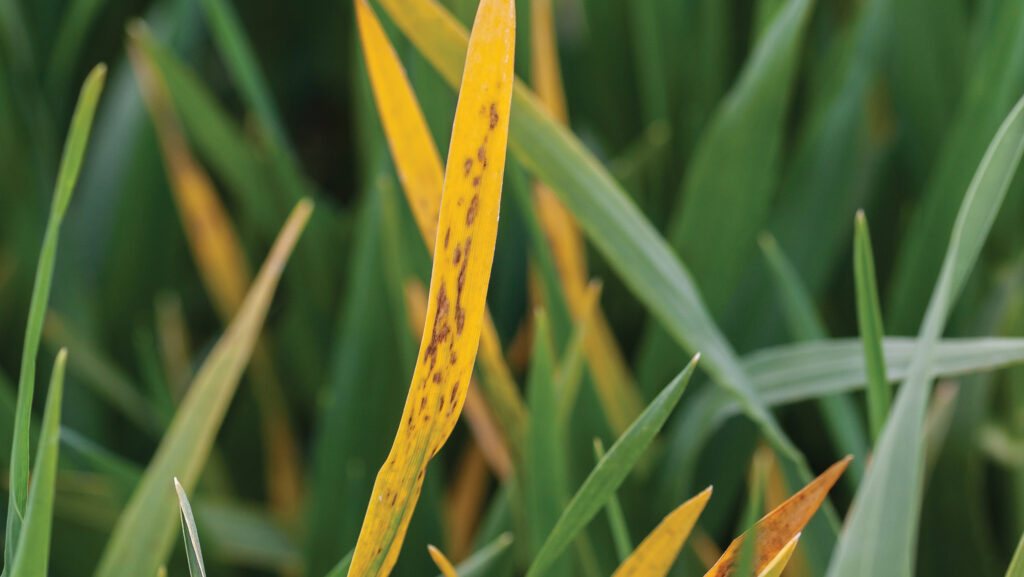High insect activity increases BYDV risk in mild autumn
 © Blackthorn Arable
© Blackthorn Arable A combination of earlier drilling and mild conditions has seen a heightened risk of insect activity, prompting concerns of barley yellow dwarf virus (BYDV) in cereal crops.
Continued mild weather this autumn has led to numerous reports of pest species in newly emerged cereal crops, including bird cherry oat aphid, grain aphid and gout fly.
Rothamsted Research suction trap data confirms bird cherry oat aphid populations were on the rise from September, with grain aphids also detected.
See also: How crop nutrition can avoid insect and disease – Farmers Weekly
Aphid vectors
Both species are potential vectors of BYDV, so any risk needs to be managed promptly as young plants are particularly susceptible to early infection, says Hutchinson’s technical manager Will Foss.
“Not all aphids will be carrying virus, but latest data indicates that on average 30% of aphids tested are viruliferous, with large differences from site to site. This is higher than the same period in 2024,” he says.
Early BYDV infection could have a significant impact on yields, cutting production by as much as 60% in badly affected crops.
Thresholds met
Agrii agronomist Andy Nash is already seeing farmers reach the threshold for insecticide treatment.
Looking after clients in the Wiltshire/Hampshire region, some farms are requiring an insecticide application for the first time in five years.
“This year seems to be a high-risk situation. Growers need to remain vigilant for threats of BYDV,” he says.
“It is all a numbers game. We are using the Contour modelling app to calculate whether crops are hitting the T-Sum threshold of 170-day degrees – and some already are.”
“We must target insecticide applications. Too early and we risk having to spray a second autumn insecticide as the clock is reset and the T-Sum model starts again.
“Too late and the second and third generation aphids will be in the crop spreading and potentially transmitting the virus across the field,” he says.
A pyrethroid, such as lambda-cyhalothrin, remains the standard insecticide of choice.
Follow-up applications may be required if the T-Sum threshold is reached again, which Andy notes resets after the first spray is applied.
The T-sum assessment
The T-sum is calculated from the accumulated average daily air temperature, above a baseline temperature of 3C, from the date of crop emergence, until the 170-day degree target.
When this is met, growers are advised to check crops for aphids and treat with a pyrethroid insecticide if numbers are high.
Nutrition focus
Neil Harper, Agrii agronomist in Kent explains that due to the warm conditions and earlier drilling, crops are hitting the T-Sum of 170-day degrees at a younger growth stage than usual, making them more susceptible to BYDV.
Neil predicts that 60% of farmers have drilled crops seven to 10 days earlier than usual, with 90% of wheat now successfully planted.
A close eye on crop nutrition will be essential to ensure crops withstand pest and disease attack.
He recommends applying zinc to help reduce symptoms of BYDV, alongside manganese and silicon to give crops a natural health boost.
If applying an insecticide, he recommends a low water rate and an angled nozzle to achieve effective coverage on what is a small target crop.
“Foliar nutrition can be applied in the tank mix alongside the insecticide,” he advises.
For farmers who opted for the Sustainable Farming Incentive (SFI) insecticide-free option, Neil recommends growing resistant or tolerant varieties as the main form of cultural control, alongside later drilling and effective use of nutrition.
However, he warns that where natural plant biostimulants claim to have insecticide control properties, these cannot be used in the SFI option.
“Given the high-pressure this season, some farms are considering opting out of insecticide-free option as the risk outweighs the payment,” he says.
Sussex wheat crop
Mike Thornton, head of crop production at agronomy group ProCam, says the BYDV threat is particularly high this season, with warm days in September driving the risk.
“BYDV is always a concern, but this year the pressure is even greater, with temperatures still hitting the twenties through late September,” explains Mike.
Standing in a field of Bamford wheat drilled in the last week of September near Lewes in East Sussex, Mike points out the crop already had its first insecticide treatment by mid-October.
“This is a high-risk part of the country, and I anticipate we may have to spray twice this autumn. A grower in the area last year sprayed four times on one block,” he says.
“When we were close to the T-170 threshold, I went out and saw aphids in the crop so recommended spraying straight away,” Mike says.
“You really need to be organised and act quickly when conditions allow, the earlier the infection, the greater the impact. Stunted and reddened crops are the typical signs of early BYDV damage,” explains Mike.
Cultural controls
Delayed drilling remains one of the most effective measures to reduce BYDV pressure, as it avoids peak aphid migration.
Although late drilling is not always practical on exposed or heavier land, if growers can wait until mid-October and ensure the green bridge is destroyed beforehand it can make a difference.
The Bamford crop was drilled at the end of September following a min-till system, with rotational ploughing helping to maintain a good root structure.
However, the earlier drilling date did mean the first insecticide was still required.
There are BYDV-resistant varieties available, such as Goldfinch and Wolverine, but uptake remains limited due to other agronomic weaknesses.
“Goldfinch can suffer badly from lodging and weak straw, while Wolverine has poor septoria resistance. They’re not ideal for this part of the country where disease pressure is high,” says Mike.
However, he is optimistic that improved resistant varieties will arrive in the next three to five years, giving growers a more robust choice.
“The weather, location and drilling date all affect your risk. Online services are a useful tool, but nothing replaces physically checking the crops. If you see aphids, or hit the degree-day threshold, don’t delay,” is Mike’s key message.
High alert for gout fly pressure this autumn
Gout fly pressure is notably high this season, with eggs already detected on several cereal crops this autumn.
Treatment thresholds are based on 50% of plants having eggs at growth stage 12.
Agrii agronomist Neil Harper says: “We saw a few eggs last year but nothing like the pressure this year.
“There have been reports of crops already meeting the treatment threshold initially in crops of early-drilled winter barley, but now winter wheats,” he says.
Gout fly are typically 4-5mm long, yellow with black markings, and lay white/ pale cream-coloured cigar-shaped eggs on cereal leaves as soon as crops emerge.
“They lay eggs on the underside of leaves, which appear as little white dots similar to a small grain of rice,” says Neil.
These hatch into the tiller and “balloon up”, causing a bulge in the stem, which when cut open reveals a maggot that kills the tiller from the inside out.
If the 50% threshold is reached, Neil recommends applying an insecticide such as lambda-cyhalothrin before the eggs hatch.
“This is the same insecticide for barley yellow dwarf virus control, so treatments can coincide with each other,” he says.
Early attacks are likely to do the most damage, which is why timely responses are essential.
Damaged crops may develop stunted, thickened “gouted”, tillers that are most noticeable in early spring.
If sufficient control is not met, there can be carryover into the spring, with spring crops at greater risk of attack due to their limited tillering abilities.
As eggs are often on the underside of the leaf, effective spray coverage can be a challenge.
That’s why Neil recommends insecticides as a last resort and advises using angled nozzles and the minimum water dose to ensure good coverage of the target area.

